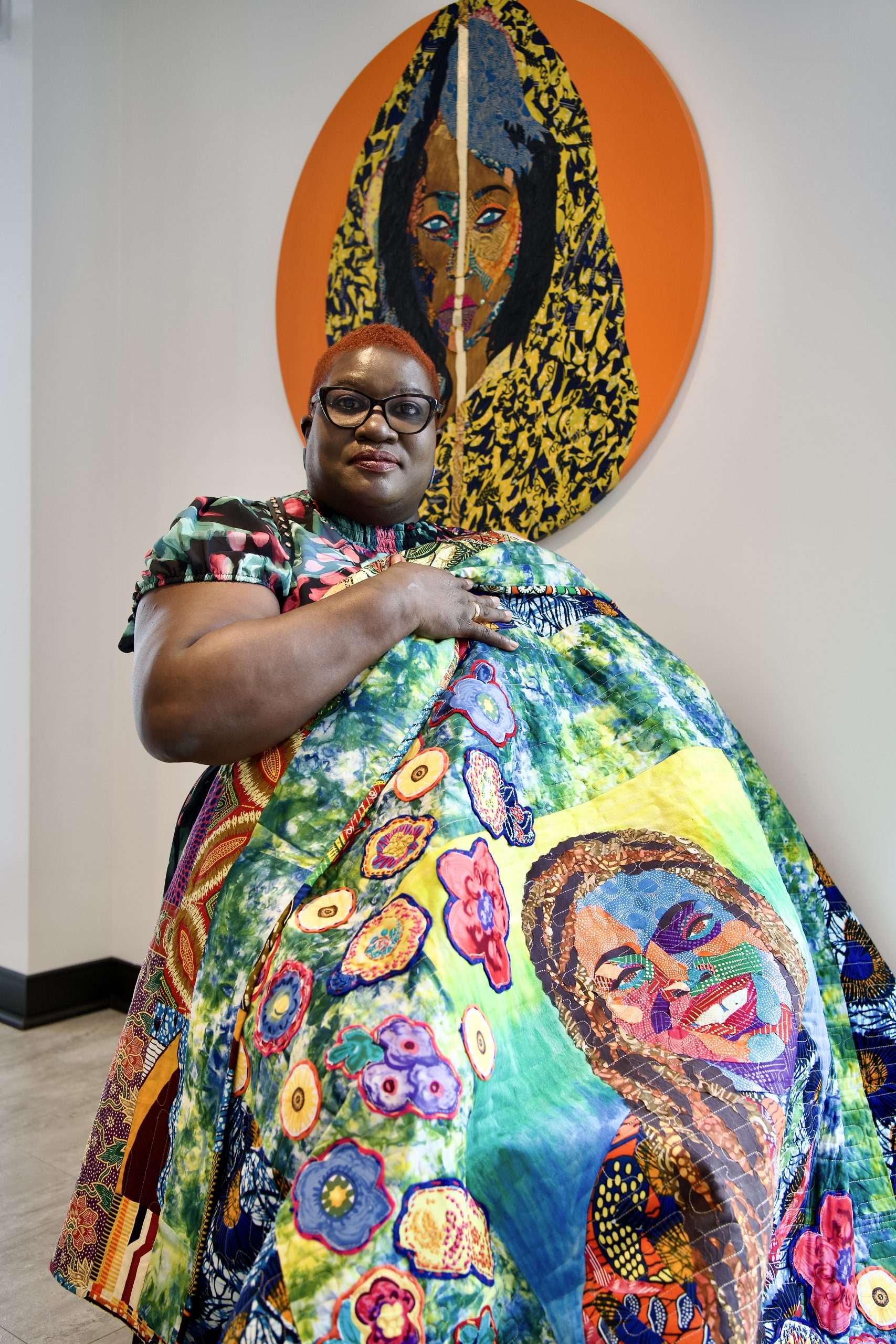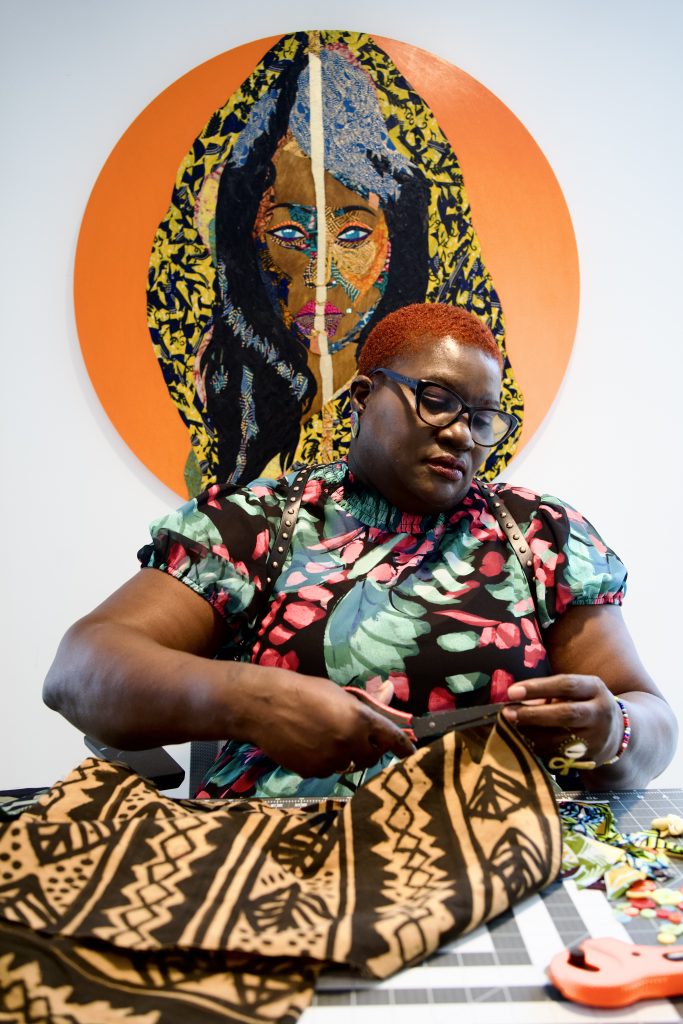AiR: Apanaki Temitayo Uses Textiles to Explore Traditional Mas
By Nia Centre, p
Posted on January 4, 2024

When you speak to Black artists in Toronto, they will tell you that one of their major concerns is the future of space in this city. When we renovated Nia Centre for the Arts, we knew that carving out an artist studio for creatives to work, innovate and dream would be essential. This past Fall, multidisciplinary artist Apanaki Temitayo joined us as the first Artist in Residence in the new building. Her work, which uses fabric to connect the spiritual and cultural worlds of the Caribbean and West Africa, was the perfect way to inaugurate this new space in the building.
Apanaki’s practice is best described as textile collage. In her own words, she treats fabric like paint. Using materials from West Africa, she creates images that invoke the deeply spiritual and celebratory practices of the Caribbean. In the last few years, Apanaki has racked up a wealth of incredible experiences. From being the sole Canadian artist to showcase at the annual African American Fiber Art Exhibition in South Carolina, to her extensive work with Workman Arts and speaking with the World Health Organization on mental health in the arts sector, Apanaki’s career has been impressive. Most are surprised to learn that she only began working as a visual artist in her early 40s. After almost a decade working as a chef at Metro Hall, the mother of three experienced a mental breakdown that led to the restart of her life. It was in a trauma workshop for women, where the facilitator used textiles for art therapy, that her life would be changed. This experience led her to buy her first canvas and she has been on an artist’s journey ever since.
In the months that Apanaki has spent in the artist studio, the space has become her own. On either side of the work room, the artist's large quilted fabrics : one that depicts her youngest daughter and the other dedicated to carnival figure Moko Jumbie, hang proudly on the walls. Stencils, scrap fabrics, yarn and paper notes animate the space with Apanaki’s vibrant energy. The workspace, which sits at street level, features a large open window that faces Oakwood Avenue. Residents of the neighborhood frequently pass by to glance through the window and wave hello. They peek at her work and watch her use the sewing machine, intrigued by the intricate tapestries she sews.
Originally from the island of Trinidad and Tobago, Apanaki is deeply influenced by the cultural and spiritual heritage of the land. The island, which has birthed carnival, calypso and soca imbued her with a strong sense of pride and celebration of the fierce resistance and ingenuity of the people. Despite being thousands of miles from West Africa, Apanaki’s relationship with cloth like kitenge and ankara began in Trinidad. “Back home, I would buy African fabric and get dresses made. I always felt called to those fabrics, even when I didn’t know where those prints came from” she says. “When I first became a visual artist, I thought ‘how can I meld my love for African fabric and art?”
Throughout the residency, Apanaki has been working on a 5-piece quilt collection that explores the social and cultural politics of the Trinidad and Tobago carnival. “I have a great reverence for people who do traditional mas,” she explains. “Mas has always been political, a chance to step outside of yourself…a resistance. I’m interested in the conversation about how the continent and people who resisted slavery have inspired the characters we see at carnival now”.

One of the prominent characters Apanaki worked with during the residency is Jab Molassie. The character, portrayed by masqueraders covered in molasses and paint, accompanied by a tin drum is understood as a devil/imp who comes to terrorize. Apanaki describes this darker side of carnival as an integral part of the celebration and she works to uncover its deeper meanings and symbolism of resistance to enslavement. “Carnival has always been a time of empowerment for people. People who are older, working class, from the LGBTQ community, expressing body positivity … it’s a chance to shed who you are and become who you want to be” she explains. “Traditional mas characters embody that spirit of resistance for us.To be able to render characters like this is a chance to give back to T&T”.
As a largely self-taught, independent artist that strays from the conventions of the traditional art world : the idea of place is central to Apanaki’s work. When we ask her about her pathway in the arts, she laughs and says “I like to poke at people who think higher education is the only way to become an artist”. The places that have been central to her development as an artist aren’t the big institutions on her resume but rather the hard fought for spaces intentionally created for artists. In the ‘90s, Temitayo was part of one of the original cohorts of the Fresh Arts Program - a JobsOntario Youth Initiative that graduated local heroes like Kardinall Offishal and Jully Black. She joined the program as a spoken word poet, where she was able to find mentors and peers in her community who wanted to change the landscape of Black Canadian art.
This residency is Temitayo’s first in her 10-year visual arts career. She has worked with the centre before, showcasing her work with us at the Harbourfront Centre in 2020. In some ways, this residency feels like a homecoming. “As an artist, it feels so good to see your work going from your dining room table to being larger than life on the front of a building”. When we come back to the topic of spaces for artists, Temitayo affirms this. “To have a dedicated space that is for us, by us, where we know that the audiences we create for can actually access this work...it’s more than needed during this time.”
Interested in Apanaki’s practice? Follow the artist on Instagram and shop her work at Shop Apanaki.
About the Artist in Residence Program
Nia Centre’s AiR program provides a small annual cohort of Black artists with the resources, tools and support necessary to jumpstart their careers.
You can learn more about the program here.
Copyright © 2024 Nia Centre for the Arts All Right Reserved.